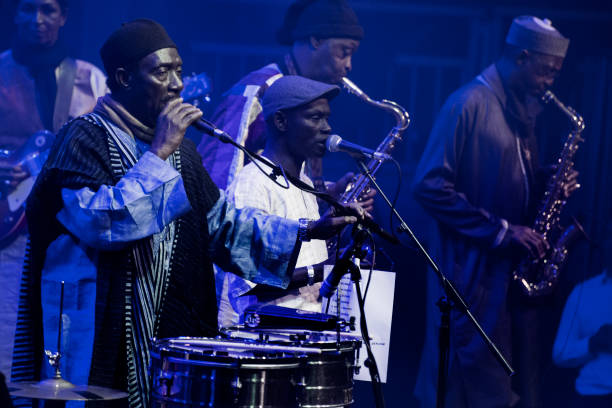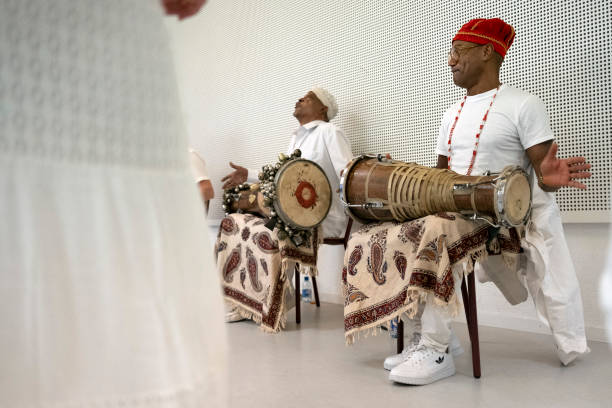The genesis of Afro-Cuban drumming instruments is deeply intertwined with the transatlantic slave trade. Enslaved Africans, primarily from West and Central Africa, were brought to Cuba with their rich musical traditions. Over time, these African rhythms and instruments melded with Spanish musical elements, giving birth to unique Afro-Cuban percussion styles. This fusion not only preserved African cultural heritage but also laid the foundation for new musical genres that would resonate worldwide.

Key Afro-Cuban Drumming Instruments
Afro-Cuban music boasts a diverse array of percussion instruments, each contributing unique sounds and rhythms. Here are some of the most prominent:
1. Batá Drums
Batá drums hold a sacred place in Afro-Cuban religious practices, especially within Santería ceremonies. A standard batá ensemble comprises three drums:
- Iyá: The largest drum, known as the “mother,” produces deep, resonant tones.
- Itótele: The medium-sized drum offers mid-range pitches, bridging the sonic gap between the Iyá and Okónkolo.
- Okónkolo: The smallest drum delivers higher-pitched sounds, adding sharp accents to the ensemble.
Each drum features two heads, allowing for a range of tones and facilitating complex polyrhythms essential to religious rituals.
2. Congas
Congas, also known as tumbadoras, are tall, barrel-shaped drums integral to various Afro-Cuban music genres. Traditionally crafted from wood with calfskin heads, modern congas often utilize synthetic materials for durability. Played with the hands, congas produce a rich palette of sounds, from deep bass tones to sharp slaps. They are central to genres like rumba, son, and salsa, providing the rhythmic heartbeat that drives the music.
3. Timbales
Timbales are metal-framed drums with plastic heads, typically played with sticks. Originating in the early 20th century, they evolved from European timpani and became a staple in Cuban dance music. A standard timbale setup includes two drums mounted on a stand, accompanied by cowbells and woodblocks. Timbales produce sharp, staccato sounds that add excitement and drive to genres like mambo, cha-cha-chá, and Latin jazz.
4. Bongos
Bongos consists of two small, open-bottomed drums of different sizes, known as the macho (larger) and hembra (smaller). Played with the fingers and palms, bongos offer a wide range of tones, from muted taps to resonant open notes. They are prominent in genres like son cubano and salsa, providing intricate rhythmic patterns and melodic accents that enhance the music’s complexity.
5. Claves
Claves are a pair of short, thick wooden sticks that produce a sharp, clicking sound when struck together. Beyond being instruments, the term “clave” also refers to the foundational rhythmic pattern in Afro-Cuban music. This pattern serves as the structural backbone for many genres, guiding the interplay between various rhythmic elements.
6. Güiro
The güiro is a hollow gourd with parallel notches carved along its surface. By scraping a stick along these notches, musicians produce a raspy, rhythmic sound that adds texture to the ensemble. The güiro is commonly used in genres like son, salsa, and cumbia, providing a distinctive rhythmic flavor.
Tumbao: The Rhythmic Flow
Tumbao refers to the rhythmic pattern played by the bass or congas in an ensemble. It gives flow and movement to the music, with basic rhythms featuring accents on the upbeat to beat 2 and the downbeat of 4. This pattern is essential for creating the lively, dynamic energy of Afro-Cuban music.
Cultural Connections: Cuba and the Canary Islands
Cuba’s history as a prosperous sugar colony in the 19th century attracted immigrants from the Canary Islands seeking work opportunities in the sugar and tobacco industries. Despite the decline of mass migration after the 1929 crash, cultural exchanges between Cuba and the Canary Islands have left a lasting impact.
The vibrant music and dance traditions in both regions share elements such as rhythm, percussion, and dance techniques. This interconnectedness underscores the enduring cultural ties between these communities.
The Influence of Afro-Cuban Drumming Instruments on Music
The impact of Afro-Cuban drumming instruments extends far beyond the shores of Cuba. Their distinctive rhythms and sounds have permeated various music genres worldwide, influencing jazz, rock, and even classical compositions.
Global Reach
In the mid-20th century, Afro-Cuban rhythms began to infiltrate the jazz scene, leading to the development of Afro-Cuban jazz. Pioneers like Dizzy Gillespie and Chano Pozo collaborated to blend jazz harmonies with Cuban percussion, creating a vibrant, new sound. This fusion introduced instruments like congas and bongos to a broader audience, cementing their place in global music.
Modern Music Integration
Today, Afro-Cuban percussion instruments are ubiquitous in various music genres. In popular music, congas and bongos add depth and rhythm to tracks, while timbales provide dynamic fills in rock and pop songs. The clave rhythm has become a fundamental element in Latin music, influencing countless compositions and arrangements.
Traditional Ensembles in Afro-Cuban Music
Over time, the number and styles of instruments used in Afro-Cuban music evolved, leading to the formation of various ensembles:
- Comparsa: Played during carnival traditions, featuring congas, bombos, cowbells, frying pans, and trumpets.
- Charanguita: Performed at countryside parties with an accordion, timbales, and güiro.
- Coro de Clave: A street choir accompanied by guitars, claves, and a stringless viola used as a drum.
- Rumba: A choir accompanied by congas, shakers, and sticks or spoons.
- Orquesta Típica: Originated in the 1800s, evolving from ensembles with clarinets, horns, trumpets, and tympani to those with timbales and reduced horn sections.
- Charanga Francesa: Emerged in the early 1900s with wood flutes, violins, pianos, contrabass, timbales, and güiro.
- Trío, Sexteto, Septeto, Conjunto, and Combo: These ensembles grew progressively larger, incorporating more instruments and creating new sounds for smaller clubs and larger performances.
Salsa: The Rhythm of Diversity
Salsa encompasses a range of rhythmic styles and instrumentations rooted in Cuban, Puerto Rican, Dominican, and other origins. Central to salsa is the clave rhythm, which provides structure and unity to diverse musical expressions. Salsa performers and arrangers adhere strictly to this rhythmic pattern, making it a hallmark of the genre.
FAQs
What is the significance of clave in Afro-Cuban music?
Clave is the rhythmic foundation of Afro-Cuban music. It provides structure for polyrhythms, improvisations, and melodic lines, making it an essential element of the genre.
How did African and European cultures influence Afro-Cuban music?
African slaves brought percussive instruments and rhythms, while European immigrants introduced strings, woodwinds, and keyboards. The fusion of these influences created the rich, diverse sound of Afro-Cuban music.
What are some key instruments in Afro-Cuban music?
Key instruments include the batá drums, congas, clave, güiro, and timbales. Each plays a unique role in creating the genre’s distinct rhythms and melodies.
How did migration shape Afro-Cuban music?
Migration, particularly from Africa and Europe, brought diverse cultural influences to Cuba. These interactions led to the creation of hybrid instruments and musical styles.
What role does tumbao play in Afro-Cuban music?
Tumbao provides the rhythmic flow and movement in Afro-Cuban music, particularly in ensemble performances. It’s a vital element for creating the genre’s dynamic energy.
Afro-Cuban music stands as a testament to the rich tapestry woven from African and European cultural threads. Central to this vibrant musical tradition are the percussion instruments that provide its distinctive rhythms and textures. This exploration of the history, instruments, and global influence of Afro-Cuban music underscores its profound impact on both Cuban and international music traditions.
